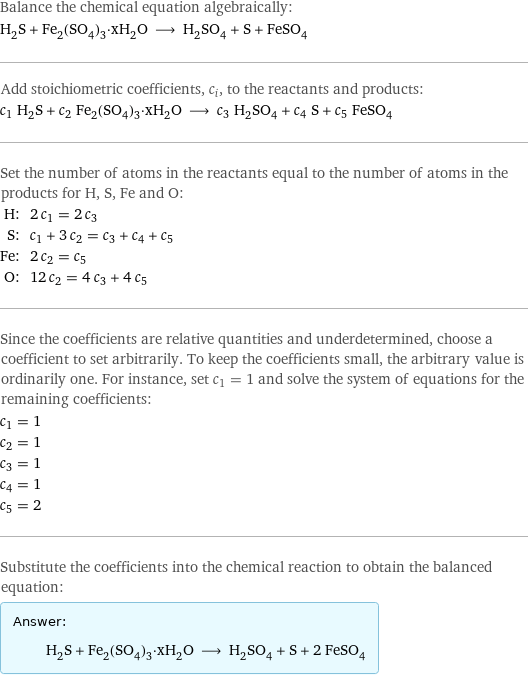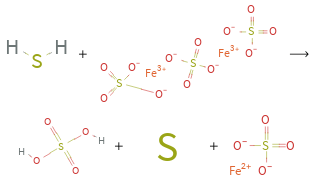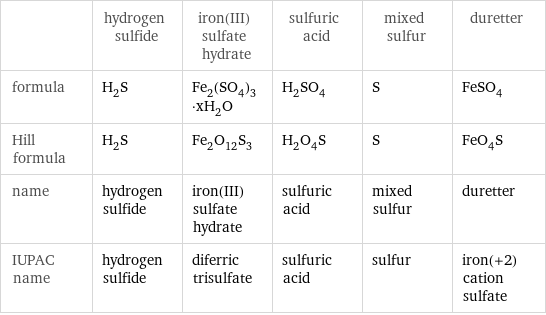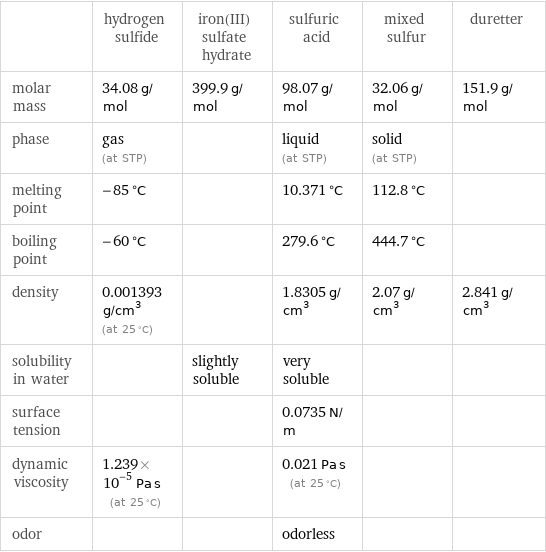Input interpretation

H_2S hydrogen sulfide + Fe_2(SO_4)_3·xH_2O iron(III) sulfate hydrate ⟶ H_2SO_4 sulfuric acid + S mixed sulfur + FeSO_4 duretter
Balanced equation

Balance the chemical equation algebraically: H_2S + Fe_2(SO_4)_3·xH_2O ⟶ H_2SO_4 + S + FeSO_4 Add stoichiometric coefficients, c_i, to the reactants and products: c_1 H_2S + c_2 Fe_2(SO_4)_3·xH_2O ⟶ c_3 H_2SO_4 + c_4 S + c_5 FeSO_4 Set the number of atoms in the reactants equal to the number of atoms in the products for H, S, Fe and O: H: | 2 c_1 = 2 c_3 S: | c_1 + 3 c_2 = c_3 + c_4 + c_5 Fe: | 2 c_2 = c_5 O: | 12 c_2 = 4 c_3 + 4 c_5 Since the coefficients are relative quantities and underdetermined, choose a coefficient to set arbitrarily. To keep the coefficients small, the arbitrary value is ordinarily one. For instance, set c_1 = 1 and solve the system of equations for the remaining coefficients: c_1 = 1 c_2 = 1 c_3 = 1 c_4 = 1 c_5 = 2 Substitute the coefficients into the chemical reaction to obtain the balanced equation: Answer: | | H_2S + Fe_2(SO_4)_3·xH_2O ⟶ H_2SO_4 + S + 2 FeSO_4
Structures

+ ⟶ + +
Names

hydrogen sulfide + iron(III) sulfate hydrate ⟶ sulfuric acid + mixed sulfur + duretter
Equilibrium constant
![Construct the equilibrium constant, K, expression for: H_2S + Fe_2(SO_4)_3·xH_2O ⟶ H_2SO_4 + S + FeSO_4 Plan: • Balance the chemical equation. • Determine the stoichiometric numbers. • Assemble the activity expression for each chemical species. • Use the activity expressions to build the equilibrium constant expression. Write the balanced chemical equation: H_2S + Fe_2(SO_4)_3·xH_2O ⟶ H_2SO_4 + S + 2 FeSO_4 Assign stoichiometric numbers, ν_i, using the stoichiometric coefficients, c_i, from the balanced chemical equation in the following manner: ν_i = -c_i for reactants and ν_i = c_i for products: chemical species | c_i | ν_i H_2S | 1 | -1 Fe_2(SO_4)_3·xH_2O | 1 | -1 H_2SO_4 | 1 | 1 S | 1 | 1 FeSO_4 | 2 | 2 Assemble the activity expressions accounting for the state of matter and ν_i: chemical species | c_i | ν_i | activity expression H_2S | 1 | -1 | ([H2S])^(-1) Fe_2(SO_4)_3·xH_2O | 1 | -1 | ([Fe2(SO4)3·xH2O])^(-1) H_2SO_4 | 1 | 1 | [H2SO4] S | 1 | 1 | [S] FeSO_4 | 2 | 2 | ([FeSO4])^2 The equilibrium constant symbol in the concentration basis is: K_c Mulitply the activity expressions to arrive at the K_c expression: Answer: | | K_c = ([H2S])^(-1) ([Fe2(SO4)3·xH2O])^(-1) [H2SO4] [S] ([FeSO4])^2 = ([H2SO4] [S] ([FeSO4])^2)/([H2S] [Fe2(SO4)3·xH2O])](../image_source/1198f360a74963bb9d59f952cd939911.png)
Construct the equilibrium constant, K, expression for: H_2S + Fe_2(SO_4)_3·xH_2O ⟶ H_2SO_4 + S + FeSO_4 Plan: • Balance the chemical equation. • Determine the stoichiometric numbers. • Assemble the activity expression for each chemical species. • Use the activity expressions to build the equilibrium constant expression. Write the balanced chemical equation: H_2S + Fe_2(SO_4)_3·xH_2O ⟶ H_2SO_4 + S + 2 FeSO_4 Assign stoichiometric numbers, ν_i, using the stoichiometric coefficients, c_i, from the balanced chemical equation in the following manner: ν_i = -c_i for reactants and ν_i = c_i for products: chemical species | c_i | ν_i H_2S | 1 | -1 Fe_2(SO_4)_3·xH_2O | 1 | -1 H_2SO_4 | 1 | 1 S | 1 | 1 FeSO_4 | 2 | 2 Assemble the activity expressions accounting for the state of matter and ν_i: chemical species | c_i | ν_i | activity expression H_2S | 1 | -1 | ([H2S])^(-1) Fe_2(SO_4)_3·xH_2O | 1 | -1 | ([Fe2(SO4)3·xH2O])^(-1) H_2SO_4 | 1 | 1 | [H2SO4] S | 1 | 1 | [S] FeSO_4 | 2 | 2 | ([FeSO4])^2 The equilibrium constant symbol in the concentration basis is: K_c Mulitply the activity expressions to arrive at the K_c expression: Answer: | | K_c = ([H2S])^(-1) ([Fe2(SO4)3·xH2O])^(-1) [H2SO4] [S] ([FeSO4])^2 = ([H2SO4] [S] ([FeSO4])^2)/([H2S] [Fe2(SO4)3·xH2O])
Rate of reaction
![Construct the rate of reaction expression for: H_2S + Fe_2(SO_4)_3·xH_2O ⟶ H_2SO_4 + S + FeSO_4 Plan: • Balance the chemical equation. • Determine the stoichiometric numbers. • Assemble the rate term for each chemical species. • Write the rate of reaction expression. Write the balanced chemical equation: H_2S + Fe_2(SO_4)_3·xH_2O ⟶ H_2SO_4 + S + 2 FeSO_4 Assign stoichiometric numbers, ν_i, using the stoichiometric coefficients, c_i, from the balanced chemical equation in the following manner: ν_i = -c_i for reactants and ν_i = c_i for products: chemical species | c_i | ν_i H_2S | 1 | -1 Fe_2(SO_4)_3·xH_2O | 1 | -1 H_2SO_4 | 1 | 1 S | 1 | 1 FeSO_4 | 2 | 2 The rate term for each chemical species, B_i, is 1/ν_i(Δ[B_i])/(Δt) where [B_i] is the amount concentration and t is time: chemical species | c_i | ν_i | rate term H_2S | 1 | -1 | -(Δ[H2S])/(Δt) Fe_2(SO_4)_3·xH_2O | 1 | -1 | -(Δ[Fe2(SO4)3·xH2O])/(Δt) H_2SO_4 | 1 | 1 | (Δ[H2SO4])/(Δt) S | 1 | 1 | (Δ[S])/(Δt) FeSO_4 | 2 | 2 | 1/2 (Δ[FeSO4])/(Δt) (for infinitesimal rate of change, replace Δ with d) Set the rate terms equal to each other to arrive at the rate expression: Answer: | | rate = -(Δ[H2S])/(Δt) = -(Δ[Fe2(SO4)3·xH2O])/(Δt) = (Δ[H2SO4])/(Δt) = (Δ[S])/(Δt) = 1/2 (Δ[FeSO4])/(Δt) (assuming constant volume and no accumulation of intermediates or side products)](../image_source/89a7522ffa445f2789f9e959af862308.png)
Construct the rate of reaction expression for: H_2S + Fe_2(SO_4)_3·xH_2O ⟶ H_2SO_4 + S + FeSO_4 Plan: • Balance the chemical equation. • Determine the stoichiometric numbers. • Assemble the rate term for each chemical species. • Write the rate of reaction expression. Write the balanced chemical equation: H_2S + Fe_2(SO_4)_3·xH_2O ⟶ H_2SO_4 + S + 2 FeSO_4 Assign stoichiometric numbers, ν_i, using the stoichiometric coefficients, c_i, from the balanced chemical equation in the following manner: ν_i = -c_i for reactants and ν_i = c_i for products: chemical species | c_i | ν_i H_2S | 1 | -1 Fe_2(SO_4)_3·xH_2O | 1 | -1 H_2SO_4 | 1 | 1 S | 1 | 1 FeSO_4 | 2 | 2 The rate term for each chemical species, B_i, is 1/ν_i(Δ[B_i])/(Δt) where [B_i] is the amount concentration and t is time: chemical species | c_i | ν_i | rate term H_2S | 1 | -1 | -(Δ[H2S])/(Δt) Fe_2(SO_4)_3·xH_2O | 1 | -1 | -(Δ[Fe2(SO4)3·xH2O])/(Δt) H_2SO_4 | 1 | 1 | (Δ[H2SO4])/(Δt) S | 1 | 1 | (Δ[S])/(Δt) FeSO_4 | 2 | 2 | 1/2 (Δ[FeSO4])/(Δt) (for infinitesimal rate of change, replace Δ with d) Set the rate terms equal to each other to arrive at the rate expression: Answer: | | rate = -(Δ[H2S])/(Δt) = -(Δ[Fe2(SO4)3·xH2O])/(Δt) = (Δ[H2SO4])/(Δt) = (Δ[S])/(Δt) = 1/2 (Δ[FeSO4])/(Δt) (assuming constant volume and no accumulation of intermediates or side products)
Chemical names and formulas

| hydrogen sulfide | iron(III) sulfate hydrate | sulfuric acid | mixed sulfur | duretter formula | H_2S | Fe_2(SO_4)_3·xH_2O | H_2SO_4 | S | FeSO_4 Hill formula | H_2S | Fe_2O_12S_3 | H_2O_4S | S | FeO_4S name | hydrogen sulfide | iron(III) sulfate hydrate | sulfuric acid | mixed sulfur | duretter IUPAC name | hydrogen sulfide | diferric trisulfate | sulfuric acid | sulfur | iron(+2) cation sulfate
Substance properties

| hydrogen sulfide | iron(III) sulfate hydrate | sulfuric acid | mixed sulfur | duretter molar mass | 34.08 g/mol | 399.9 g/mol | 98.07 g/mol | 32.06 g/mol | 151.9 g/mol phase | gas (at STP) | | liquid (at STP) | solid (at STP) | melting point | -85 °C | | 10.371 °C | 112.8 °C | boiling point | -60 °C | | 279.6 °C | 444.7 °C | density | 0.001393 g/cm^3 (at 25 °C) | | 1.8305 g/cm^3 | 2.07 g/cm^3 | 2.841 g/cm^3 solubility in water | | slightly soluble | very soluble | | surface tension | | | 0.0735 N/m | | dynamic viscosity | 1.239×10^-5 Pa s (at 25 °C) | | 0.021 Pa s (at 25 °C) | | odor | | | odorless | |
Units
